Here Comes the Cavalry – US Cavalry in The D-Day America Book
By Chad Underdonk,
Last winter when Battlefront announced the return to late-war in V4 my heart began to pound a little faster as I’ve always been a big fan of the M8 Greyhounds and Jeeps of the US Cavalry. I immediately examined the announced title page of the US D-Day book and was a little upset to learn that there was no Reconnaissance formation listed for the United States. And worse, upon examination, I realized that the Germans, British, and Russians all had a reconnaissance formation on their title pages. So with much trepidation, I’ve been awaiting word of what is going on with my beloved US Cavalry.
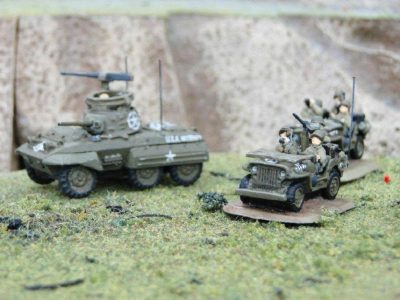 To top that off I know all about the complaints of “armored car spam” for mid-war, and the negative impression it gave some folks of the state of Flames of War for Mid-War. So I was afraid that bad things for my boys were coming down the line. Well after being offered the chance to write this article, I was able to peruse the documents…and I am largely happy with the results. As a long-time player of the Cavalry Troops (that’s a Company y’all!) I’ll also be sharing some of the insights learned over years of play, and how they translate to V4.
To top that off I know all about the complaints of “armored car spam” for mid-war, and the negative impression it gave some folks of the state of Flames of War for Mid-War. So I was afraid that bad things for my boys were coming down the line. Well after being offered the chance to write this article, I was able to peruse the documents…and I am largely happy with the results. As a long-time player of the Cavalry Troops (that’s a Company y’all!) I’ll also be sharing some of the insights learned over years of play, and how they translate to V4.
First, we have the basic building block of the Cavalry Force, the Patrol. In the new D-Day book each Cavalry Recon Patrol is organized as 1 or 2 M8 Greyhounds, 1 MG Jeep, and 1 Mortar Jeep. Right off that brings us to some interesting developments because we can simulate either of the two main recon formations that the United States used in Western Europe.
In previous editions of the game, the first list in print after D-Day was in the V2 book “Cobra”. That list represented the Armored Reconnaissance Battalions of the 2nd and 3rd Armored Divisions. That “Heavy” Battalion used four Companies composed of 3 platoons, each having 2 patrols which used the 2 M8s and 2 Jeep variation.
Other reconnaissance units were typical called Cavalry Reconnaissance Mechanized formations and retained the pre-war Cavalry terminology of Troop (a company-sized unit) and Squadron (a battalion-sized unit). Those Squadrons had 3 Troops composed of 3 platoons, each having 3 patrols which used only 1 M8 and 2 Jeep variation.
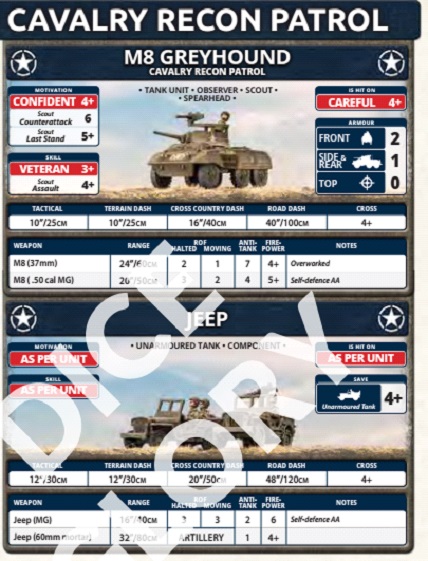 In V4 the 2 Greyhound patrol variation is probably a little stronger because it is easier to keep in good spirits after taking casualties. Considering the last stand is a 5+ (somewhat standard for Recon units in the game) being able to take an additional casualty before checking is useful. That is of course historically limited to the 2nd and 3rd Armored Divisions, and it does cost an extra 2 points to add that additional Greyhound.
In V4 the 2 Greyhound patrol variation is probably a little stronger because it is easier to keep in good spirits after taking casualties. Considering the last stand is a 5+ (somewhat standard for Recon units in the game) being able to take an additional casualty before checking is useful. That is of course historically limited to the 2nd and 3rd Armored Divisions, and it does cost an extra 2 points to add that additional Greyhound.
Other changes we see with our M8 Greyhounds include being Careful (hit on a 4+), Veteran (3+ Skill), and Confident (4+ motivation) as all good scouts should be. This allows the Cavalry Patrols to Blitz, and Shoot and Scoot on a 3+, and to Follow Me on a 4+. Of course, this is balanced out for an open-topped Scout by a reduced Assault rating of 4+, and very poor counter-attack rating of 6+. This means the Greyhounds can potentially get a good swing in on isolated guns or heavily-reduced infantry teams, but they are highly unlikely to stick around to fight additional rounds. It also means they won’t hold ground well if assaulted by infantry. The Jeeps are a “Component” team, which means that they share the ratings of their parent unit.
Other changes for V4 include improved armor on the M8 Greyhound of 2 front, 1 side, and 0 top (compared to 1,0,0 in previous editions). I always felt that the Greyhounds were hamstrung in earlier editions by a lower than necessary speed. In V4 the tactical speed of 10″ is reasonable, and the Road Dash is a very nice 40″ if that should ever be useful for a Spearhead move. Armament wise, the Greyhound is a little worse off than previous editions. The 37mm gun is now overworked (presumably because the vehicle Commander was also the loader), and there is no stat-line for the co-axial .30 caliber machine gun. The .50 caliber is a mixed bag as in V4 it is now a reduced rate of fire of 2 on the move, but it does have an improved 20 inches of range.
In some builds, I believe the most powerful weapon that the Greyhound will be able to apply will be its 3+ Skill Observer trait. Every Cavalry Patrol has the ability to call for artillery fire, even while Blitzing or Shooting and Scooting, and with Scout, they are more likely to survive the trip getting there. In artillery heavy builds that could make lists with multiple Cavalry Patrols somewhat better at both attacking and defending. it also means that one Patrol can call for fire from the mortar jeeps of other Patrols.
The other component of the Patrol is the Jeep teams. They have lost some survivability in V4 with a 4+ save instead of a 3+. Don’t forget to use Bullet Proof Cover to improve their survivability! They still remain a little bit faster than the Greyhounds at a 12″ tactical speed and a 48″ Road Dash. That simply increases the range on those rare missions where you can use Spearhead to your advantage.
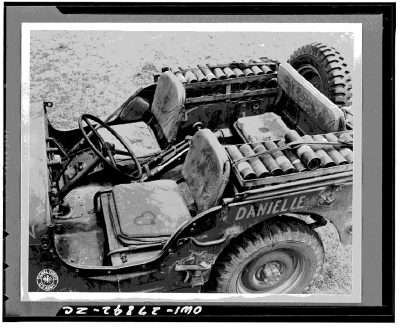 Unlike previous editions there is no provision made to up-arm your mortar jeeps with more machine-guns. And the 60mm mortar (which is rapidly deployed from the jeep, fired from the ground, and then quickly thrown back in before taking off down the road) no longer has direct fire capability, but instead fires as a one gun barrage, with its parent unit’s 3+ skill! Of course that requires it to sit still to shoot at your opponent…but in many ways is more effective with V4s repeat bombardment benefits. Best of all V4 allows you the flexibility to use some of the field doctrine and maneuvers of Cavalry Patrols by effectively splitting your teams up beyond command range.
Unlike previous editions there is no provision made to up-arm your mortar jeeps with more machine-guns. And the 60mm mortar (which is rapidly deployed from the jeep, fired from the ground, and then quickly thrown back in before taking off down the road) no longer has direct fire capability, but instead fires as a one gun barrage, with its parent unit’s 3+ skill! Of course that requires it to sit still to shoot at your opponent…but in many ways is more effective with V4s repeat bombardment benefits. Best of all V4 allows you the flexibility to use some of the field doctrine and maneuvers of Cavalry Patrols by effectively splitting your teams up beyond command range.
The .30 caliber jeep provides more volume of fire, and another team to be shot at. Interestingly as a Component Unit, the M8 abilities transfer to the Jeeps as well, and if a Jeep inherits the Leadership position, it too can be an Observer. Perhaps my biggest complaint of the V4 Jeep teams is that since they are unarmored tank teams they may not assault. In reality, these small teams often cleared houses or roadblocks while the Greyhounds provided over-watch. Perhaps stripping the “unarmored” from the profile would allow them to perform as in real life.
Just as in real life, the essential function of the Recon Patrol is controlling space, tying up enemy units and making them hesitant to move…or punishing them when they do. Their goal is to pin enemy units either through fire or indecision, and then to guide heavier forces, or artillery onto the target to reduce its combat ability. And they do all of this well at the cost of only 3 points per Patrol (i.e. platoon in FOW terms).
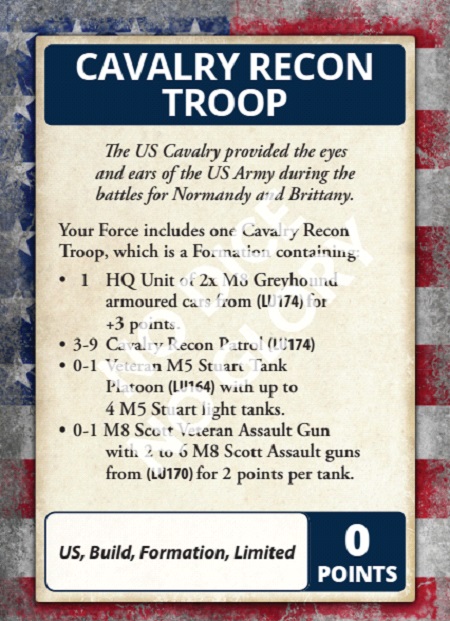 As you may have guessed from my description of the historic terminology and organization of Cavalry units, I was very much interested in how larger units of Cavalry forces were going to be organized. While two patrols as support may be all that many players need… I have a desire to play, more, more, more. I pointed out earlier there is no Cavalry formation in the D-Day book. Instead, the formation is available in the Command Cards, and it gets the job done fairly well.
As you may have guessed from my description of the historic terminology and organization of Cavalry units, I was very much interested in how larger units of Cavalry forces were going to be organized. While two patrols as support may be all that many players need… I have a desire to play, more, more, more. I pointed out earlier there is no Cavalry formation in the D-Day book. Instead, the formation is available in the Command Cards, and it gets the job done fairly well.
The Cavalry Recon Troop gives you the flexibility to play either of the historic styles of US Cavalry with 3-9 Patrols. It allows you to buy an HQ unit of 2 M8 Greyhounds for 3 points; representing the Cavalry Reconnaissance Troops. It also allows you add up to 4 Veteran M5 Stuarts or up to 6 M8 Scotts.
These choices represent the F Company, which fielded 17 M5a1 Stuarts, or E Troop which had 6 M8 Scotts divided into 3 batteries (8 M8 Scotts in Armored Reconnaissance Battalions, with 4 batteries). For added list building flexibility or strength, you could add a Veteran (or regular) Light Tank Company with its own 2-3 Gun Battery of M8 Scotts. While Scotts only have a 4+ skill they are still very useful for their points in providing smoke barrages and digging out guns and infantry when time allows. A 6 gun battery provided via the card would gain re-rolls to hit, while two 3 gun batteries would give more smoke. Most importantly, adding M5a1 Stuarts to your Cavalry list gives you more reliable counter-attacks and cross-checks. Both Scotts and Stuarts have a 3+ Tactics rating and are Careful (hit on 4+), so they are just as good at using movement orders as Cavalry Patrols.
So then what style of Cavalry Formation / Organization would you want to add to your American Army? Well, that depends a lot on how big you want to go. Anything from a Patrol (3-5pts) or two as support, up through a Cavalry Reconnaissance Troop with multiple “platoons” each with multiple Patrols (as few as 12 points), or even a full-blown Squadron consisting of a Cavalry Recon Troop (as many as 33pts) and a Cavalry Light Tank Company (up to 44 points for Veterans) and/or a Cavalry Howitzer Troop (up to 12 or even 16 points for Veterans.)
In theory, an Armored Reconnaissance Battalion (2nd or 3rd AD) with all the trimmings would come in at 93 points, and a Cavalry Squadron would come in at 86 points. That still leaves a smidge of room for other support, or you can quite easily dial back any or all of the elements of that squadron to fit almost as many supporting elements as you could ever desire. In previous versions, I likened the Cavalry to a “Universal Adaptor” for the US Army because they could literally take bits and pieces of almost everything and always have a historic precedent.
But why would you want to field squadron sized elements in the first place? Doesn’t that just go back to the earlier statement that “armored cars” are overrunning the game? Well, yes and no. Yes, it would be a lot of light vehicles, but the price of Medium tanks has dropped so far in late-war that I can’t ever see light vehicles being a serious threat to the balance of the game. No, questions of the historic use don’t apply to US Cavalry in late-war as they very much operated on Troop (company), Squadron (battalion), and Group levels throughout the campaign in Western Europe. In fact, it is my opinion that the US Cavalry in WW2 is largely unsung heroes who by their efforts were force multipliers in the most direct sense.
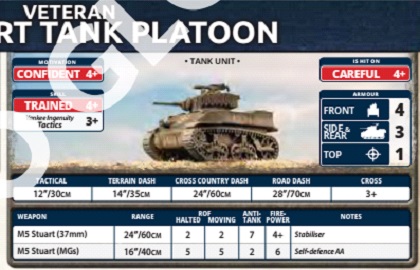 Before the commencement of combat during WW2 it was theorized that US Cavalry Mechanized forces would operate as often as possible as pure recon. They would stealthily seek out information about the enemies dispositions, avoid combat as much as possible, and disengage from combat as quickly as possible.
Before the commencement of combat during WW2 it was theorized that US Cavalry Mechanized forces would operate as often as possible as pure recon. They would stealthily seek out information about the enemies dispositions, avoid combat as much as possible, and disengage from combat as quickly as possible.
In reality, that doctrine was deeply flawed. In experience, most Cavalry Commanders fell back on traditional “Cavalry Tactics” and reworked the elements of patrolling, screening, attack, defense, pursuit, and other traditional cavalry roles for use while mechanized. In fact in the “Mechanized Cavalry Analysis 1946” one of the amalgamations of many units found that the average time spent by most Cavalry Mechanized Reconnaissance units broke down as 10.2% offensive, 32.8% defensive, 3.3% reconnaissance, 24.9% security, and 28.8% special operations.
Additionally, those reports found that on average Cavalry Troops spent 36.1% of their time mounted, and 63.9% dismounted (though that option is not available in the new book). It also makes clear that it was their flexibility to switch roles to achieve the mission at hand which leads to their great success at enhancing the information, movements, disposition, power, and safety of the entire force.
In essence they provided economy of force on many levels which allowed in some cases for a reinforced Cavalry Squadron to recon hundreds of miles in just a few days, to provide defense in areas that an entire Army Corps was needed to replace them when they were moved, to screen divisional flanks from counter-attack, protect rear areas, provide pursuit, engage in direct attack, and in all ways provide the organizational commander a jack-of-all-trades unit. They could accomplish the missions that would otherwise slow or degrade the main force if it was tasked to execute these. Frequently those missions would change over the course of a couple of hours and the Cavalry would be reassigned to achieve another urgent mission.
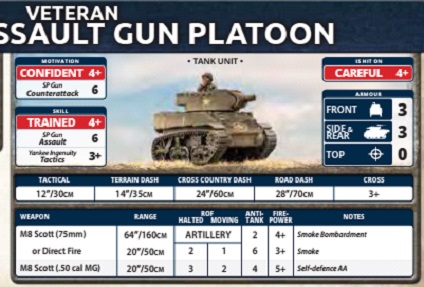 While carrying out these missions, the Cavalry forces were often assigned to Infantry or Armor Divisions as supplemental units, as Corp or Army assets for information gathering and dissemination (Patton found that using the Cavalry as an Army Informational Corps reduced the time for intelligence to be passed and disseminated from the front to HQ from over 8 hours to just over 2 hours time).
While carrying out these missions, the Cavalry forces were often assigned to Infantry or Armor Divisions as supplemental units, as Corp or Army assets for information gathering and dissemination (Patton found that using the Cavalry as an Army Informational Corps reduced the time for intelligence to be passed and disseminated from the front to HQ from over 8 hours to just over 2 hours time).
Often Cavalry organizations (minus constituent parts on their own missions) were given other units to create a task force to accomplish desired missions. These add on units often included: Rangers, Infantry, Artillery, Armored Infantry, Tanks, Engineers, Tank Destroyers in units up to Battalion size. Reading about the exploits of these men, and the incredible things they accomplished always inspires my sense of awe. And playing this force, even as light as it is, is often a challenge that I thoroughly enjoy.
So let’s take a look at how some of these Cavalry based Task Forces might look in V4 Flames of War
Example Cavalry List #1 Offensive Operations (Attack choice)
46 Points Cavalry Recon Troop Card
HQ (one Greyhounds)
Patrol (one Greyhound, one Mortar Jeep, one MG Jeep)
Patrol (one Greyhound, one Mortar Jeep, one MG Jeep)
Patrol (one Greyhound, one Mortar Jeep, one MG Jeep)
Patrol (one Greyhound, one Mortar Jeep, one MG Jeep)
Patrol (one Greyhound, one Mortar Jeep, one MG Jeep)
Patrol (one Greyhound, one Mortar Jeep, one MG Jeep)
Patrol (one Greyhound, one Mortar Jeep, one MG Jeep)
Patrol (one Greyhound, one Mortar Jeep, one MG Jeep)
Patrol (one Greyhound, one Mortar Jeep, one MG Jeep)
Veteran Light Tank Platoon (four M5a1 Stuarts)
Veteran Howitzer Platoon (three M8 Scott Howitzers)
24 Points Ranger Company
Ranger HQ (one SMG)
Ranger Platoon (seven rifle teams, one 60mm mortar)
Ranger Platoon (seven rifle teams, one 60mm mortar)
Ranger Mortar Platoon (two 81mm mortars)
10 Points 105mm Field Artillery Batteries (four M2a1 105mms)
10 Points 105mm Field Artillery Batteries (four M2a1 105mms)
10 Points 105mm Field Artillery Batteries (four M2a1 105mms)

Example Cavalry List #2 Defensive Operations (Defend choice)27 Points Cavalry Recon Troop Card
HQ (2 Greyhounds)
Patrol (one Greyhound, one Mortar Jeep, one MG Jeep)
Patrol (one Greyhound, one Mortar Jeep, one MG Jeep)
Patrol (one Greyhound, one Mortar Jeep, one MG Jeep)
Patrol (one Greyhound, one Mortar Jeep, one MG Jeep)
Patrol (one Greyhound, one Mortar Jeep, one MG Jeep)
Patrol (one Greyhound, one Mortar Jeep, one MG Jeep)
Veteran Assault Gun Platoon (three M8 Scott Howitzers)
28 Points Engineer Company Card
Engineer HQ (two SMG teams)
Engineer Platoon (five Rifle teams, three Bazooka teams, two HMG teams)
Engineer Platoon (five Rifle teams, three Bazooka teams, two HMG teams)
Engineer Platoon (five Rifle teams, three Bazooka teams, two HMG teams)
12 Points 3″ Tank Destroyer Platoon (four 3-Inch Guns)
16 Points Tank Destroyer Platoon (four M10 Wolverines)
16 Points 105mm Armored Field Artillery Batteries (six Priests)
1 Point Luck Card
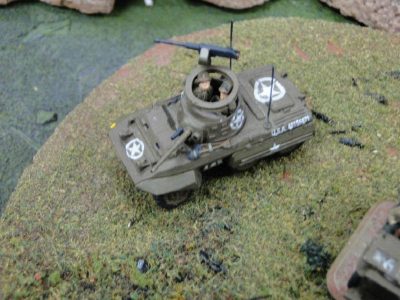 Example Cavalry List #3 Pursuit / Reconnaissance (Maneuver or Attack choice)
Example Cavalry List #3 Pursuit / Reconnaissance (Maneuver or Attack choice)
36 Points Cavalry Recon Troop Card
HQ (one Greyhounds)
Patrol (one Greyhound, one Mortar Jeep, one MG Jeep)
Patrol (one Greyhound, one Mortar Jeep, one MG Jeep)
Patrol (one Greyhound, one Mortar Jeep, one MG Jeep)
Patrol (one Greyhound, one Mortar Jeep, one MG Jeep)
Patrol (one Greyhound, one Mortar Jeep, one MG Jeep)
Patrol (one Greyhound, one Mortar Jeep, one MG Jeep)
Patrol (one Greyhound, one Mortar Jeep, one MG Jeep)
Patrol (one Greyhound, one Mortar Jeep, one MG Jeep)
Patrol (one Greyhound, one Mortar Jeep, one MG Jeep)
Veteran Howitzer Platoon (three M8 Scott Howitzers)
50 Points Veteran Light Tank Company
HQ (two M5a1 Light Tanks)
Light Tank Platoon (five M5a1 Light Tanks)
Light Tank Platoon (five M5a1 Light Tanks)
Light Tank Platoon (five M5a1 Light Tanks)
Veteran Assault Gun Platoon (three M8 Scott Howitzers)
9 Points P-47 Thunderbolt Fight Flight (two P47s)
2 Points 370th Fighter Group Card (Napalm bombs)
2 Points French Resistance Raid
1 Point Lucky Card
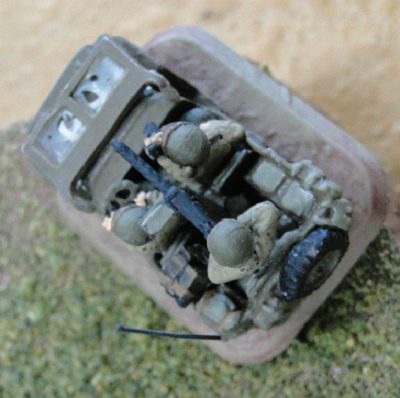 Example Cavalry List #4 Security / Screening (Maneuver or Defend choice)
Example Cavalry List #4 Security / Screening (Maneuver or Defend choice)
27 Points Cavalry Recon Troop Card
HQ (2 Greyhounds)
Patrol (one Greyhound, one Mortar Jeep, one MG Jeep)
Patrol (one Greyhound, one Mortar Jeep, one MG Jeep)
Patrol (one Greyhound, one Mortar Jeep, one MG Jeep)
Patrol (one Greyhound, one Mortar Jeep, one MG Jeep)
Patrol (one Greyhound, one Mortar Jeep, one MG Jeep)
Patrol (one Greyhound, one Mortar Jeep, one MG Jeep)
Veteran Assault Gun Platoon (three M8 Scott Howitzers)
37 Points Veteran Light Tank Company
HQ (two M5a1 Light Tanks)
Light Tank Platoon (five M5a1 Light Tanks)
Light Tank Platoon (five M5a1 Light Tanks)
Veteran Assault Gun Platoon (three M8 Scott Howitzers)
15 Points Armored Rifle Platoon (Six Rifle, 5 Bazooka, two LMG, 1 60mm Mortar, 5 Halftracks)
12 Points 3″ Tank Destroyer Platoon (four 3-Inch Guns)
6 Points 4.2 Inch Chemical Mortars Card (4 Chemical Mortars)
2 Points French Resistance Raid
1 Point Lucky Card
I hope this article and sample lists help to inspire others to look more closely at fielding these exciting and dynamic US Cavalry formations in Flames of War. Battlefront has provided us aspiring US Cavalry players quite a canvas to work with and I am truly excited.
Toujours Pret!
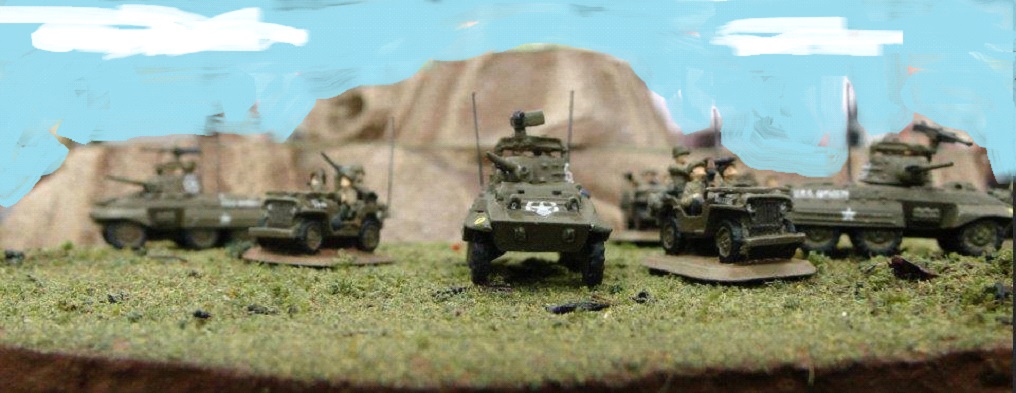

Hurrah Chad, excellent inspiring article on a flexible and challenging force! Cavalry Forward!
Oops. Lists #1 & 3 should both have 2 Greyhounds in the HQ sections.